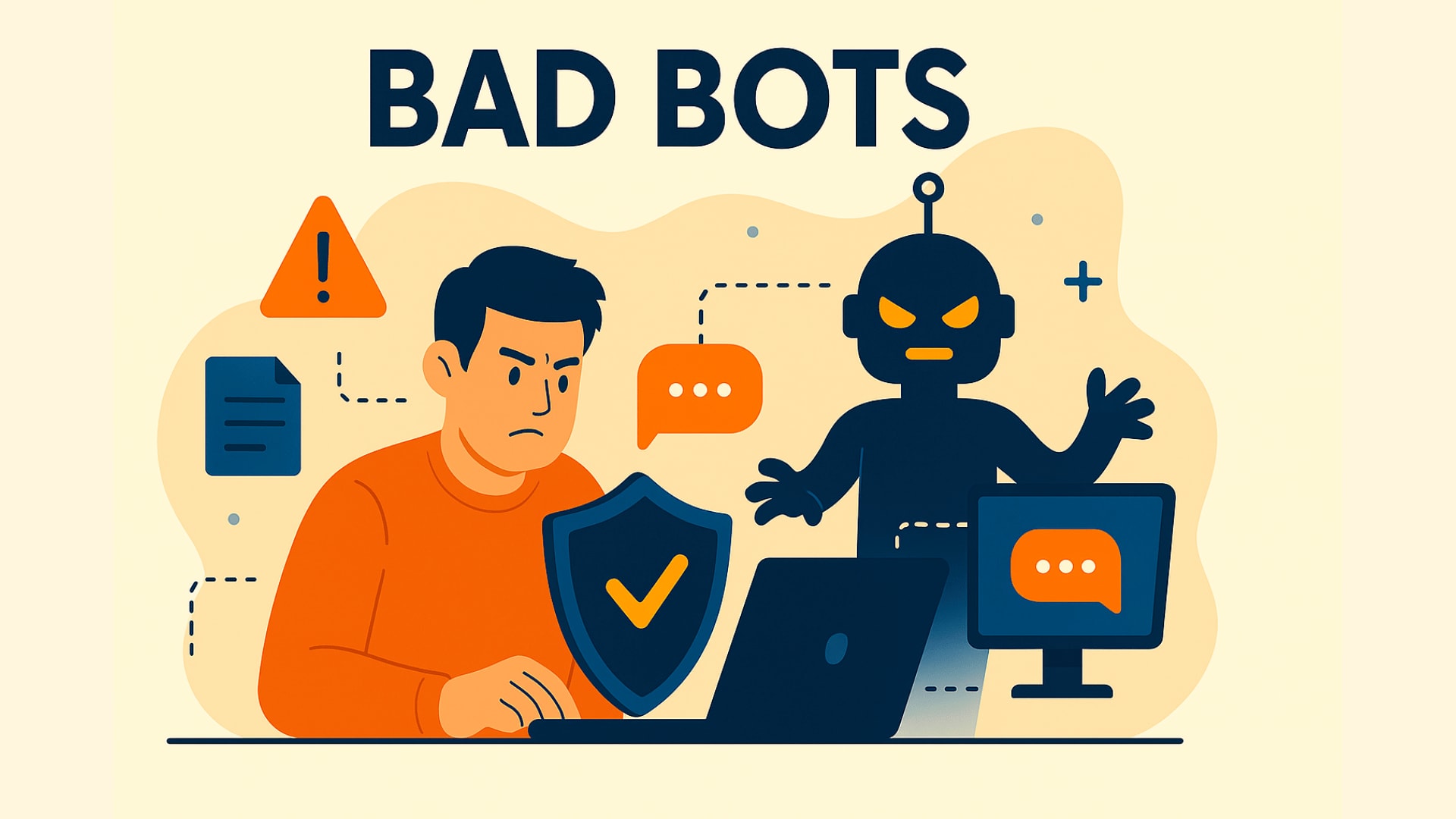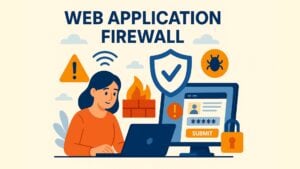
The internet may be built for people, but increasingly, it’s dominated by machines. According to the 2025 Bad Bot Report, more than half of all internet traffic now originates from bots. Even more alarming, 37% of this traffic stems from malicious actors using them not for productivity or indexing, but for fraud, disruption, and exploitation. These findings underscore a stark reality for online businesses: They are no longer a peripheral problem. They are central to the cybersecurity landscape and demand immediate, informed action.
Table of contents
- Blurred Line Between Bots and Humans
- Surge in Bad Bot Activity
- How Bots Evade Detection
- Motivations Behind Bot Attacks
- Industry-Specific Trends and Vulnerabilities
- Bots and API Exploitation
- Defensive Strategies and Adaptive Protection
- Evolving CAPTCHA Technology as a Defence Tool
- Conclusion
- FAQ – Frequently Asked Questions
Blurred Line Between Bots and Humans
To understand the threat, we must first define what a bot is. At its core, a bot is a piece of software that performs automated tasks over the internet. Some are helpful — search engine crawlers, like Googlebot, index websites so that users can find them in search results. Customer service bots can answer basic questions quickly. However, not all of them serve positive purposes.
Bad bots are specifically programmed for nefarious goals. They mimic human interactions, bypass access controls, and exploit online services. Their activities include data scraping, account takeover, payment fraud, and denial-of-service attacks. They are designed to operate undetected, blending in with legitimate users, and often succeeding in doing so.
Surge in Bad Bot Activity
The past year marked a turning point: automated traffic officially surpassed human-generated traffic for the first time in a decade. More than 51% of internet activity now comes from bots. This dramatic increase is largely due to advancements in AI and automation tools. Large language models and AI-driven software have made bot development more accessible, allowing even low-skilled attackers to deploy sophisticated bots.
The growing accessibility of these tools has led to a steep rise in simple bot attacks. Although they use basic scripts from a single IP address and lack human-like behaviour, their volume and frequency have exploded. Simultaneously, more advanced bots have become increasingly evasive, emulating human behaviour with remarkable accuracy — including mimicking mouse movements and keyboard inputs.
How Bots Evade Detection
One of the most challenging aspects of modern bot mitigation is detecting their presence. The most successful bots avoid detection by appearing like real users. They impersonate popular browsers, particularly Chrome, which remains the top choice due to its ubiquity. Security systems that automatically trust common user agents are often tricked by this technique.
They also use residential proxies to hide their origin. By routing their activity through real user devices, they appear to be coming from regular households. In 2024, over one-fifth of bad bot traffic was delivered through such proxies. Combined with the use of privacy tools like iCloud Private Relay and headless browser frameworks enhanced with AI, they have become extremely difficult to distinguish from real visitors.
Motivations Behind Bot Attacks
Why do attackers use bots in the first place? The motivations are diverse, but all converge on one theme: financial or strategic gain at the expense of legitimate users and businesses. Account takeover attacks are among the most damaging, allowing attackers to use stolen credentials to access user data and conduct unauthorized transactions. These attacks have increased dramatically, up 40% from the previous year.
Data scraping is another frequent motive. They scan and extract large volumes of product, pricing, or personal data, often to be resold or used competitively. Retailers suffer from automated purchasing during product launches, while travel websites see bots manipulating fare availability or reserving seats without purchase. Other attack goals include exploiting payment systems, abusing promotional codes, or conducting denial-of-service campaigns that degrade website performance.
Industry-Specific Trends and Vulnerabilities
While bad bots affect nearly every sector, some industries have experienced sharper increases. In a notable shift, the travel industry surpassed retail to become the most attacked vertical, now representing 27% of all bot traffic. Travel sites face unique risks, such as bots reserving airline tickets or hotel rooms without intent to purchase, preventing legitimate bookings.
Retail, the second most affected industry, continues to grapple with bots that target high-demand product releases, commit gift card fraud, or scrape competitive pricing data. Financial services, education platforms, and telecom providers are also prime targets due to the value of the data they hold and the disruption potential bots present.
Bots and API Exploitation
As digital infrastructure modernises, APIs have become a central target for bot activity. Automated attacks on APIs can result in unauthorized data scraping, account takeover, or even transactional fraud — all without a traditional browser interface. Because many businesses lack visibility into API-layer traffic, these attacks often go undetected. That’s why it’s vital to extend bot protection strategies beyond your website, securing both public and private APIs with rate limiting, authentication checks, and behavioural anomaly detection.
Defensive Strategies and Adaptive Protection
Effective defence begins with understanding where and how you’re vulnerable. Businesses should start by mapping out sensitive areas of their digital environment — login forms, checkout flows, exposed APIs — and fortifying them. Traditional security tools are no longer sufficient in isolation. A modern bot mitigation strategy must include layered protection.
Behavioural analysis tools help by identifying users who behave too quickly, too consistently, or too unnaturally. Fingerprinting technologies track subtle characteristics of devices and browsers to detect suspicious patterns. It’s also crucial to set up rate limits, block access from known data centre IPs, and monitor for anomalies in traffic volume or source distribution.
During high-risk events, such as product drops or ticket sales, event-based protection strategies can be activated. Virtual waiting rooms, CAPTCHA challenges, and even member-only access gates can be used to slow down or filter traffic, giving genuine users a fair chance and reducing infrastructure strain.
Evolving CAPTCHA Technology as a Defence Tool
CAPTCHAs remain an essential line of defence. However, as bots grow more intelligent, traditional CAPTCHA solutions are increasingly bypassed. Many of them now use AI to solve visual or audio challenges, or offload them to low-cost human solving services.
That’s why it’s critical to implement more advanced, user-friendly alternatives. Next-generation CAPTCHA systems, like those developed by captcha.eu, go beyond static image tests. They leverage behavioural signals, interaction patterns, and adaptive challenges to verify human users while minimizing friction. Combined with other mitigation strategies, modern CAPTCHAs remain a powerful tool against automated abuse.
Conclusion
The 2025 Bad Bot Report is a wake-up call. Automated traffic is now the norm, and much of it is malicious. With bots attacking across industries, devices, and platforms, no business is immune.
Protecting your digital assets starts with recognising the scale of the threat and deploying smart, layered defences. Behavioural monitoring, fingerprinting, rate-limiting, and evolving tools like adaptive CAPTCHA must all play a role. By embracing these defences, businesses can reduce risk, safeguard customer trust, and maintain a resilient online presence.
At captcha.eu, we understand that security should never come at the cost of usability. Our advanced, privacy-compliant CAPTCHA solutions help businesses stay ahead of the latest automated threats — without frustrating your legitimate users. In an internet increasingly shaped by bots, let’s ensure your platform remains a space for humans.
FAQ – Frequently Asked Questions
What is a bad bot?
A bad bot is an automated program designed to carry out malicious tasks online. Unlike good bots (e.g., search engine crawlers), bad bots perform activities such as credential stuffing, data scraping, and fraud — often mimicking human behavior to evade detection.
Why are bad bots dangerous for businesses?
Bad bots can lead to account takeovers, fake purchases, denial-of-service attacks, and skewed analytics. They can also consume server resources, disrupt operations, and damage customer trust, resulting in financial and reputational loss.
How much of today’s web traffic is made up of bots?
According to the 2025 Bad Bot Report, over 51% of all internet traffic now comes from bots, with 37% attributed to bad bots — a record high that marks bots as a dominant force online.
How do bad bots avoid detection?
They impersonate popular browsers, use residential proxies, exploit APIs, and simulate human behavior such as mouse movements and keystrokes. Some even use AI to bypass CAPTCHAs and detection tools.
What are evasive bots?
Evasive bots are highly advanced. They adapt quickly after being blocked, rotate IPs, mimic human interaction, and use stealth tactics like “low and slow” request rates to avoid triggering alarms.
Are CAPTCHAs still effective against bots?
Yes — but only advanced, adaptive CAPTCHAs. While basic image-based CAPTCHAs are often bypassed, next-gen CAPTCHAs that use behavioural signals and frictionless validation remain a vital layer in bot mitigation.
100 free requests
You have the opportunity to test and try our product with 100 free requests.
If you have any questions
Contact us
Our support team is available to assist you.




